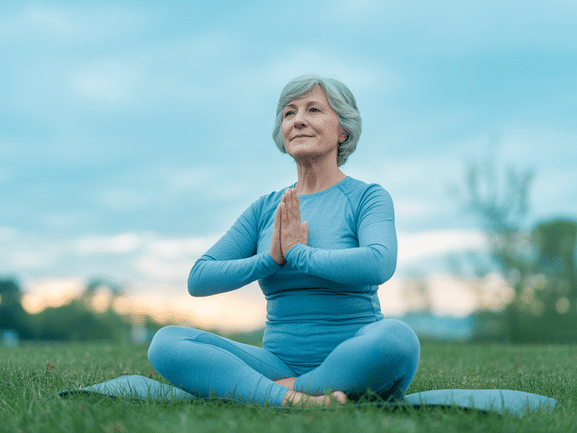Your Complete Yoga Dictionary for Chronic Pain Relief: Essential Terms Every Beginner Should Know
Living with chronic pain can feel isolating, especially when exploring new wellness practices like yoga. If you’ve been curious about yoga for chronic pain but felt overwhelmed by unfamiliar terminology, you’re not alone. This comprehensive yoga dictionary will serve as your gentle guide, helping you understand essential terms and how they relate to managing your pain naturally.
Whether you’re dealing with fibromyalgia, arthritis, chronic back pain, or other persistent conditions, understanding these fundamental yoga concepts will empower you to begin your healing journey with confidence. Let’s explore together how ancient wisdom meets modern pain management.
Why Yoga Terminology Matters for Chronic Pain Sufferers
Before diving into our yoga dictionary beginners guide, it’s important to understand that yoga isn’t just physical poses. It’s a holistic system designed to bring harmony between mind, body, and spirit. For those managing chronic pain, this comprehensive approach offers multiple pathways to relief.
Research from Harvard Medical School shows that regular yoga practice can significantly reduce chronic pain intensity while improving overall quality of life. However, knowing the right terms helps you communicate effectively with instructors and choose appropriate practices for your unique needs.
Essential Yoga Terms for Pain Management
Asana (AH-sah-nah)
Definition: The physical postures or poses in yoga practice.
For Chronic Pain: Gentle yoga poses chronic pain sufferers can practice include supported child’s pose, legs-up-the-wall, and gentle spinal twists. The key is finding asanas that feel nurturing rather than challenging. Remember, yoga isn’t about perfect alignment – it’s about finding what serves your body today.
Pranayama (prah-nah-YAH-mah)
Definition: Breathing techniques that regulate life force energy.
For Chronic Pain: Deep, conscious breathing activates your parasympathetic nervous system, naturally reducing pain perception. Try the 4-7-8 breath: inhale for 4 counts, hold for 7, exhale for 8. This simple technique can be your first line of defense during pain flares.
Restorative Yoga
Definition: A passive practice using props to support the body in comfortable positions for extended periods.
For Chronic Pain: This is often the perfect starting point for pain management. Poses are held for 5-20 minutes, allowing deep relaxation and nervous system reset. It’s like giving your body permission to heal.
Yin Yoga
Definition: A slow, meditative practice targeting deep connective tissues.
For Chronic Pain: Unlike vigorous yoga styles, Yin involves holding poses for 3-5 minutes with minimal muscular effort. This gentle approach can help improve flexibility and reduce stiffness without aggravating sensitive areas.
Props (Yoga Equipment)
Definition: Tools like bolsters, blocks, straps, and blankets that make poses more accessible.
For Chronic Pain: Props are your best friends! They allow you to experience the benefits of poses without strain. A bolster under your knees during savasana, or a block between your thighs during bridge pose can transform your practice from painful to therapeutic.
Modifications
Definition: Adjustments to traditional poses that make them safer and more comfortable.
For Chronic Pain: Every pose can be modified. Can’t sit on the floor? Use a chair. Struggling with downward dog? Try it against a wall. Your practice should adapt to you, not the other way around.
Savasana (shah-VAH-sah-nah)
Definition: The final relaxation pose, often called “corpse pose.”
For Chronic Pain: This might be the most important pose in your practice. It’s when your nervous system integrates the benefits of your session and pain relief often deepens during these quiet moments.
Mindfulness
Definition: Present-moment awareness without judgment.
For Chronic Pain: Instead of fighting pain, mindfulness teaches you to observe it with curiosity. This shift in relationship to pain can dramatically reduce suffering and increase your sense of control.
Ahimsa (ah-HIM-sah)
Definition: The principle of non-violence or non-harming.
For Chronic Pain: This includes being gentle with yourself. If a pose hurts, honor your body’s wisdom and back off. True yoga is about self-compassion, not self-punishment.
Pain-Specific Yoga Categories
Therapeutic Yoga
This therapeutic yoga terms category encompasses practices specifically designed for healing. Unlike fitness-focused yoga, therapeutic yoga prioritizes function over form, making it ideal for chronic pain management.
Chair Yoga
Perfect for days when getting on the floor feels impossible. Chair yoga maintains all the benefits of traditional practice while providing stability and support. Many poses can be adapted for seated practice, including spinal twists, shoulder rolls, and breathing exercises.
Gentle Flow
A slow-moving sequence that links breath with movement. For chronic pain sufferers, gentle flow offers the benefits of movement without high impact or intense holds.
Building Your Personal Practice
Creating a sustainable yoga routine when living with chronic pain requires patience and self-awareness. Start with just 5-10 minutes daily, focusing on breath and gentle movement. Remember, consistency trumps intensity every time.
The Vitalizen.app platform offers specially designed classes for various pain conditions, allowing you to practice at your own pace with expert guidance. Each session includes modifications and props suggestions, making yoga accessible regardless of your current limitations.
External Resources for Continued Learning
While building your yoga vocabulary, consider exploring additional resources. The Yoga Alliance provides comprehensive teacher training standards, while NIH’s National Center for Complementary and Integrative Health offers evidence-based research on yoga’s benefits for various health conditions.
Frequently Asked Questions
Can I practice yoga if I can barely move due to pain?
Absolutely! Yoga includes breath work and meditation, which require no physical movement. Even gentle eye movements or finger stretches count as yoga practice. The key is meeting yourself where you are today, not where you think you should be.
How often should I practice yoga for chronic pain relief?
Start with 5-10 minutes daily, focusing on gentle movements and breathing exercises. Consistency is more important than duration. Listen to your body and gradually increase practice time as it feels right.

